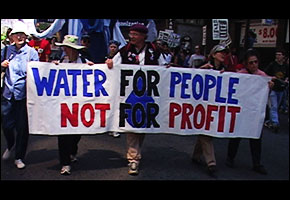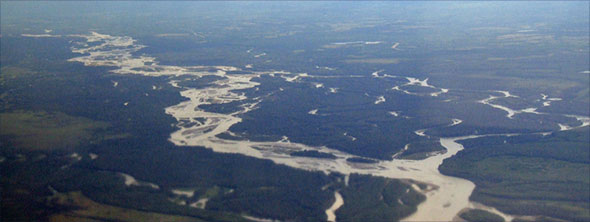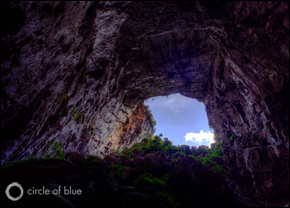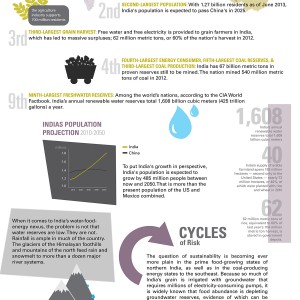EPA Water Infrastructure Survey Reveals Little About Utilities’ Climate Readiness
Though few reported climate change adaptation projects to the EPA, utilities are preparing in other ways.
By Brett Walton
Circle of Blue
Every four years, as required by Congress, the U.S. Environmental Protection Agency sends a survey to water utilities asking them to assess their infrastructure plans for the next two decades.
The survey covers projects that are eligible for a federal loan program for drinking water infrastructure – chiefly improvements to existing pipes and treatment plants, but not dams, raw-water reservoirs or outlays to accommodate growth. Thus, the survey is not a ceiling for how much utilities will spend on drinking water, but a floor.
And a lofty floor it is. Based on the fifth Drinking Water Infrastructure Needs Survey and Assessment, sent in 2011 and released last week, the EPA estimates that utilities will have to spend $US 384 billion between 2011 and 2030 to prevent water service from deteriorating.
Compliance with federal regulations is a small part of the total, 11 percent. The lion’s share, nearly two-thirds of the national need, will go toward the buried assets in the distribution system: the pipes and water mains that deliver clean water to homes and businesses.
The most interesting part of the assessment, however, is not the magnitude of infrastructure needs. The current spending estimate is roughly the same as the last edition. But the 2011 survey, for the first time, asked utilities which projects are related to climate change adaptation.
Few utilities answered. Only 44 systems, 1.4 percent of all respondents, claimed a “climate readiness” project.
Adaptation Does Not Necessarily Mean Building
There are several reasons for the near silence.
The EPA did not define what it means for a project to be “climate ready”, leaving it to the utilities to make that call. Reporting such projects also was voluntary and did not affect the distribution of federal money, the main purpose for the survey.
Some projects, like flood protection, may be covered in a citywide plan and not captured in a single utility’s spending projections. New York City, for example, announced Tuesday a $US 20 billion package for flood walls, gates, and levees.
A number of climate adaptation measures, such as operational changes, would not even be reported in the EPA survey, which emphasizes hardware.
“A lot of adaptation is not necessarily built projects,” Alison Adams, a manager at Tampa Bay Water who focuses on water sources and environmental protection, told Circle of Blue. Changes to reservoir operations or incentives to reduce demand help a utility prepare for a wackier water cycle or a reduction in supply, but they typically do not require new infrastructure.
–Alison Adams,
manager, Tampa Bay Water
The projects that were reported to the EPA do reveal the problems that utilities think are most urgent. A plurality of reported climate projects – 59 out of 164 – involved securing sources of emergency power.
This shows that utilities, at least those that responded, are concentrating on disaster preparation. Without electricity, pumps and treatment plants do not work, a point made clear last fall in the aftermath of Hurricane Sandy when power outages bedeviled treatment plants in the storm’s path.
The EPA, for its part, will use the responses from the climate readiness question as a guide post for future water infrastructure surveys.
“While the results from the 2011 survey related to climate readiness are not representative of all drinking water systems, we believe the effort has furthered our dialogue with states and the water industry on how better to gather information in this area,” Peter Grevatt, director of EPA’s Office of Groundwater and Drinking Water told Circle of Blue, in a statement.
No Crystal Ball
Still, the fact remains that most of the effects of climate change are far too uncertain right now for utilities to commit themselves to big infrastructure projects.
“Utilities can ask, ‘What will the effects be?’” David Behar, climate program director at San Francisco Public Utilities Commission, told Circle of Blue in February 2012. “And they can ask, ‘How do we make ourselves resilient?’ The second question can only be answered after the first. Right now, we’re not asking ‘How?’ We’re asking ‘What?’ And that has not been satisfactorily answered by anyone.”
Some problems, on the other hand, are already known. San Francisco is spending as much as $US 40 million in the next few years to prevent rising seas from backing up its stormwater collection system.
Both Behar and Adams are members of the Water Utility Climate Alliance (WUCA), a group of 10 large utilities who serve more than 43 million people.
Adams said that though all major utilities are considering climate change in their water supply planning, smaller utilities do not have comparable technical, scientific, or financial resources for such endeavors. WUCA wants to serve as an information clearinghouse so all utilities can access regional climate models or lists of best practices for adaptation.
But just because small utilities have fewer resources, that does not mean they are less prepared, says Mike Keegan, a policy analyst for the National Rural Water Association.
“Smaller communities may be more agile because of the simplicity of their infrastructure,” Keegan told Circle of Blue, explaining that “agile” means the ability to quickly rebuild smaller, decentralized systems.
But at times, simplicity can be a curse, the most recent example being Magdalena, New Mexico. The town of fewer than 1,000 people, is scrambling for water supplies after a persistent drought dropped the water table below the intake pipe in its sole well.
Brett writes about agriculture, energy, infrastructure, and the politics and economics of water in the United States. He also writes the Federal Water Tap, Circle of Blue’s weekly digest of U.S. government water news. He is the winner of two Society of Environmental Journalists reporting awards, one of the top honors in American environmental journalism: first place for explanatory reporting for a series on septic system pollution in the United States(2016) and third place for beat reporting in a small market (2014). He received the Sierra Club’s Distinguished Service Award in 2018. Brett lives in Seattle, where he hikes the mountains and bakes pies. Contact Brett Walton











Leave a Reply
Want to join the discussion?Feel free to contribute!